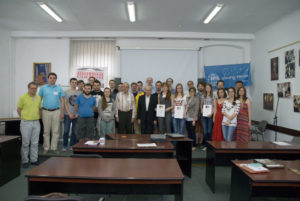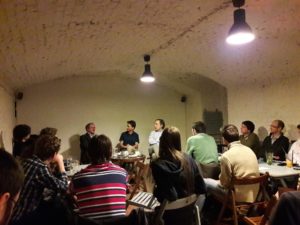 For the first time, Prague EPS Young Minds decided to organise informal events for students to meet with senior academics. Three events in total were held within the Physics Café platform – two open discussions and one pub quiz. All of these were successful beyond expectations, with average attendance of 30 people per an event. The events were advertised in form of posters, which were placed in school buildings. We also advertised it on our social sites, namely Facebook and Twitter.
For the first time, Prague EPS Young Minds decided to organise informal events for students to meet with senior academics. Three events in total were held within the Physics Café platform – two open discussions and one pub quiz. All of these were successful beyond expectations, with average attendance of 30 people per an event. The events were advertised in form of posters, which were placed in school buildings. We also advertised it on our social sites, namely Facebook and Twitter.
The first event was especially challenging for us. Since all the previous Prague EPS Young Minds event were held within the university campus, much effort was put in a search for appropriate café or a similar venue. Once this was covered, our next concern was about the number of people who would attend an event outside the campus. The topic of the first open discussion was “Physics of the 21st Century – What Does It Stand For?” and three scientists took part in it. The event attracted 29 people while about one quarter of the people attending were non-students.
The second Physics Café was organized in the collaboration with the Czech Union of Mathematicians and Physicist. This event was used for the award ceremony and the Union honored their members for their lifetime benefits for the popularization of the physics. It provided great opportunity for informal discussion on the topic “The role of scientist outside of the academic world”.
The last event from the first series of the Physics Café was dedicated to the competition known as Pub Quiz. The questions cover the topic from the world of science, especially they were focused on curious and funny facts from physics. In all cases, the official program was followed by more informal discussions.
In total, three events of the Physics Café were visited approximately by 90 people. This type of event was rated as a good idea and was attractive for students as well as for the senior academics of the Czech Union of Mathematicians and Physicist. Thanks to the positive feedback, there are not doubts, that Physics Café will continue in the future.
International Particle Physics Masterclasses 2017
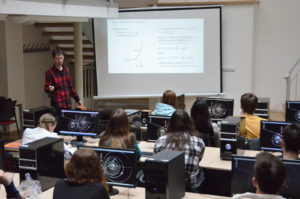 International Masterclasses is an annual event traditionally held in the first third of the year. 15 to 19 year old students are given an opportunity to discover particle physics. A total of approximately 10.000 high school students from 47 countries participate every year, effectively obtaining insight into topics and methods of basic research at the fundamentals of matter and forces. Not only are they given a chance to spend a whole day outside of school without receiving detention, but they also put their hands on an experiment themselves by performing measurements on real data from particle physics experiments at CERN. Almost 200 universities or research centres are involved in this project.
International Masterclasses is an annual event traditionally held in the first third of the year. 15 to 19 year old students are given an opportunity to discover particle physics. A total of approximately 10.000 high school students from 47 countries participate every year, effectively obtaining insight into topics and methods of basic research at the fundamentals of matter and forces. Not only are they given a chance to spend a whole day outside of school without receiving detention, but they also put their hands on an experiment themselves by performing measurements on real data from particle physics experiments at CERN. Almost 200 universities or research centres are involved in this project.
There are three participating institutes in the Czech Republic – the Institute of Physics at the Silesian University in Opava, the Institute of Particle and Nuclear Physics at the Charles University in Prague and the Faculty of Nuclear Sciences and Physical Engineering at the Czech Technical University (FNSPE CTU) in Prague.
This year’s International Particle Physics Masterclasses at the FNSPE CTU took place on April 7 2017 at the faculty’s headquarters with approximately 60 participating high-school students. The Czech part of the project is being organised in cooperation with the International Particle Physics Outreach Group, Prague EPS Young Minds section and CERN. The students are given a unique opportunity to become a particle physicist for one day without needing any prior knowledge of the subject.
In the morning, the students attended a series of instructive lectures given by scientists who actively work at CERN, whereas in the afternoon, an actual data analysis from two major LHC experiments – ATLAS and ALICE – was carried out. While analysing the experimental data from ATLAS, the students were given a chance to (re)discover the intermediate W bosons. The results were forwarded to CERN. The highlight of the day was a live videoconference with CERN physicists and with other teams from several universities abroad. At the very end, the best team (the team with the most accurate results) was proclaimed and awarded. During the day, organizers took care of having the lunch delivered as well as the preparation of refreshments, beverages and coffee for participating students.
More photos could be found at: https://flic.kr/s/aHskUQ8fPA
Physics for sustainable development & Fund Raising Concert
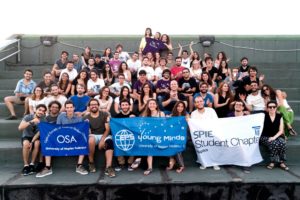 On the 23rd of June PONYS Physics & Optics Naples Young Students organized a fundraising event for the association Sunshine4Palestine. The event had two moments: a talk held by Dr. Barbara Capone from “Roma Tre” University with the title “Physics for sustainable development” and a concert on Physics Department Roof-top performed by “Roof-ini’s quintet”.
On the 23rd of June PONYS Physics & Optics Naples Young Students organized a fundraising event for the association Sunshine4Palestine. The event had two moments: a talk held by Dr. Barbara Capone from “Roma Tre” University with the title “Physics for sustainable development” and a concert on Physics Department Roof-top performed by “Roof-ini’s quintet”.
The theme of the talk, Physics for sustainable development, was very interesting: Dr. Barbara Capone told us Sunshine4Palestine projects. One of the most important was “Jenin Hospital Project”: this project implies the construction and installation of a photovoltaic power generating plant on the roof of the Jenin Charitable Hospital in Gaza. The plant has been specifically designed to cover the energy needs for the entire hospital, and to include storage energy components for emergency purposes.
Some of these projects was consisted with our activities, as, Scientific Divulgation. In collaboration with students from the Applied Science College of the Al-Aqsa University in Gaza, Sunshine4Palestine association will give rise to the first scientific divulgation project in the Gaza Strip. Many small experiments will be conducted, and some groups will work on projects to make the first pieces of what will become the first Science Museum in Gaza. After the talk, The event continued on Physics Department Roof, where the Roof-ini’s quintet’s perfomance entertained the audience and we organized the fundraiser moment for sustain Sunshine4Palestine.
Listening to how you can make your skills available by a scientist to help others has been a great stimulus and exciting for us!
Physica in Fabula
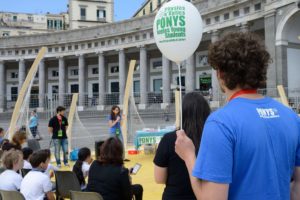 “Physica in Fabula” is born by the idea of put together two worlds apparently distant: literature and physics.
“Physica in Fabula” is born by the idea of put together two worlds apparently distant: literature and physics.
After reading a brief literary step, some simple experiments, which are related to the physical phenomena present in the story, are shown and explained; for example “Harry Potter and the Philosopher’s Stone” is linked to some experiments of geometrical optics for understanding if it is possible to recreate the Cloak of invisibility. Last piece is followed by a laboratory, called G-Lab, in which the audience realizes the experiment using poor materials, such as building a hologram prism for smartphone and tablet. This activity was presented for the first time in occasion of the presentation of the book “La Nascita Imperfetta delle Cose” by the Italian physicist Guido Tonelli, hosted by the bookstore laFeltrinelli Libri e Musica in Naples and organized by Fondazione IDIS – Città della Scienza.
In the last year “Physica in Fabula” became a real format that has been performed in various neapolitan libraries and during the XXXI edition of “Futuro Remoto”, organized by Città della Scienza.
The format has been expanded with new readings and adding some excerpts of animated movies.
Targeted mainly to children, the purpose of Physica in Fabula was to stimulate the interest both in physics and literature, using the powerful effects of literature on imagination to light the sparkle of curiosity towards physics, and showing how many real physical phenomena are hidden in the stories we are used to read.
Scientific Adventure Playground
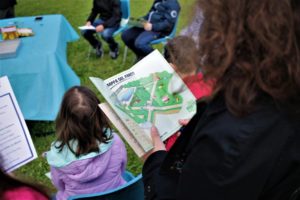 Scientific Adventure Playground is an outreach initiative designed and organized by PONYS – Physics & Optics Naples Young Students, in partnership with the Environmental Department of Naples City Council and the National Institute for Nuclear Physics.
Scientific Adventure Playground is an outreach initiative designed and organized by PONYS – Physics & Optics Naples Young Students, in partnership with the Environmental Department of Naples City Council and the National Institute for Nuclear Physics.
The idea
Playing is a very powerful way of learning, as everyone knows. Over the last years PONYS have designed a large number of demonstrative experiments, exploring different areas of physics, which have been proposed in many outreach events as a collection of separated stands. What if these very same experiments were collected in a consistent way, giving rise to a scientific game where participants can play and learn at the same time? And what if this could be done in a wonderful location, such as an urban park, delivering also an environmental message? And what if this scientific game took place in two of the toughest neighborhoods of Naples? Put all this together, and you’ll catch the idea at the heart of the Scientific Adventure Playground.
Location
The event took place in two urban parks located at the opposite sides of Naples, one week away one another:
“Villa di Scampia”, April 22ndScampia has become worldwide famous in last years because of its involvement in organized crime issues, as witnessed by Roberto Saviano’s bestseller book “Gomorra” and the subsequent screen adaptations. Its characteristic buildings, “le vele” (“the sails”) have become the symbol of the degradation of this area.
“Parco Massimo Troisi”, San Giovanni a Teduccio, April 29thEntitled to the Academy-Award-winning actor and film director Massimo Troisi, who was born in this neighborhood, this park is located just a few steps away from a huge portrait of Diego Armando Maradona, painted in 2016 by the street artist Jorit.
Target and Objectives
The event was addressed mainly to children of 8 – 13 years old, but it turned out that this kind of activity is perfectly suitable with little variations to a much larger audience.The objectives of Scientific Adventure Playground were:
• Stimulate interest in physics and science in general;
• Make children explore the urban park, walking around and discovering its beauty; • Sensitize the public to environmental issues and to the respect of public places.
The Game
The aim of the game is to explore the park using the Scientific Explorer Kit provided at the entrance, attend a number of physics experiments and overcome the challenges, namely answering some simple questions.
There are three routes to follow, of three different colors. Each route develops a topic and is divided into three stages: each stage consists in a stand focusing on a particular area of physics, thematically coherent to the whole route. The routes are:
• Waves Route, Blue – Optics, Electromagnetism, Acustic
• Elements Route, Red – Geophysics, Astrophysics, Fluid Dynamics
• Energy Route, Yellow – Combustion, Soap Bubbles, Smart Materials
Following the routes and answering the questions the visitor can fill his/her Scientific Passport with stamps, which mark his/her proceedings, and win some prizes provided he/she answers correctly to at least one question out of three for any given route.
The framework of the game provides motivation and engagement. Paying attention to the experiments is essential to answer correctly and win the prize, which works just as a catalyzer. In order to stress this point and avoid to overestimate the importance of the prize, the criteria designed to win it have been chosen carefully, focusing on the importance of the experience itself rather than on the stakes.
The Scientific Explorer Kit
At the entrance of the park, the visitor receives the Scientific Explorer Kit, containing all the necessary to play. It contains the following:
Map of the park. Drawn by PONYS, it contains some elements useful to orient yourself in the park (buildings, trees and so on) in addition to other elements which are essential to the game, such as the colored flags, which mark the stages od the routes, and the Checkpoint, where visitors go to check their answers.
Scientific Passport. It marks the proceedings of the visitor. It’s personal, customizable with Name, Surname, Date of Birth, Signature and Photo. Each box to be stamped carries the name of a famous scientist and little logo attached to it: this simple feature, besides offering the opportunity to talk about great scientists of our history, stimulates interest through the idea of “collecting scientists”.
Challenge Sheet (red, blue or yellow). It contains three multiple answer questions, related to the three stages of a given route. After answering the first Challenge Sheet, the visitor can take another sheet at the Checkpoint and continue to play, until he has finished all the routes.
The Physics Garden
This is an open area, separated from the colored routes and the question-answer game, where the link between physics and sport is investigated through interactive experiences. Many activities are covered: football, basketball, dancing, diving and others. This area allows to continue to play even after all the routes have been completed, and is particularly fitting to the park setting.
The INFN Stand
The Naples Section of the National Institute for Nuclear Physics supported the event and participated with a stand illustrating the physics of cosmic rays and how muons coming from outer space are currently used for volcanos and subsoil radiography. This part of the activity was particularly suitable to grown-up kids and adults accompanying their children
Futuro Remoto
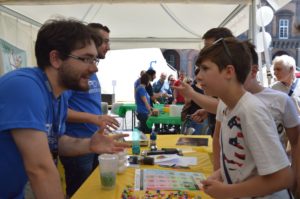 From May 25th to 28th 2017, PONYS joined “Futuro Remoto”, the most anticipated Naples science festival organized by Città della Scienza (link http://www.cittadellascienza.it/). The event was hosted in Piazza del Plebiscito, the principal square of Naples. The focus topic of this year was “Connections”, a wide theme held in all its senses.
From May 25th to 28th 2017, PONYS joined “Futuro Remoto”, the most anticipated Naples science festival organized by Città della Scienza (link http://www.cittadellascienza.it/). The event was hosted in Piazza del Plebiscito, the principal square of Naples. The focus topic of this year was “Connections”, a wide theme held in all its senses.
During the four days of the festival, PONYS presented Passione fisica (link http://ponys.fisica.unina.it/?p=1566), an activity designed as a journey through different fields of physics. The aim was to let scientifical interest araise in all the people visiting our exhibitions, by showing how complex physical phenomena can be appealing and accessible when they are made with simple experiments.
The event was designed as a scientific adventure journey, where the visitor received a customizable scientific passport and a quiz with questions about the topics discussed. Following the exhibitions and answering the questions the visitor could fill his/her Scientific Passport (link report PAS) with stamps, which marked his/her progress. Taking care of the main theme of Futuro Remoto, PONYS decided to connect with other research centers by involving them in their scientific adventure. With this idea the visitor, having the scientific passport, could go to visit other exhibitions and collect stamps from them. This idea has been a great success and involved hundreds of people.
Ranging from Electromagnetism and Optics to Geophysics and Particle Physics, most of the experiments was made of everyday materials, in order to both stimulate the audience with familiar objects and to make those experiments easily reproducible and interactive. This year acoustic experiments were introduced in order to show how to generate a sound wave. A special area was dedicated to interactive demonstrations about physics of football, basketball, dancing, diving and others.
Furthermore, PONYS realized three appointments of Physica in fabula (link report PIF) and a scientific speed dating (link report SD). The former was a funny and interesting laboratory for kids; the latter involved several scientists to answer public’s questions.
Also this year more than 100 volunteers among students, PhD, researchers and professors of the Physics Department of the University of Naples joined this PONYS experience!
XVII Workshop and Award for young researchers in the field of statistical physics and condensed matter theory
The 17th Workshop and Award for young researchers in the field of statistical physics and condensed matter theory supported by EPS Young Minds Committee was held in Lviv at the Institute for Condensed Matter Physics on June 8–9, 2017. The event was dedicated to the 100th anniversary of Abba Glauberman (1917–1974), a famous Ukrainian physicist who worked in Ivan Franko Lviv State University (1948–1966) and contributed to development of quantum theory of solid state and statistical theory of condensed systems.
Young researchers in statistical physics and condensed matter theory had an opportunity to present their own results during the Workshop as well as compete for the competition prize. This year the reports of participants were particularly striking. Two of them – Olesia Krupnitska and Vasyl’ Kharchenko – were awarded for the best presentations by Special Individual Awards. Four other young participants – Tetiana Rokhmanova, Vasyl’ Vasyuta, Olha Shchur and Oleksiy Zdorevskiy – were distinguished by the Competition Committee as the most promising ones. In general, 22 young researchers not only from Lviv, but from Sumy, Dnipro, Kyiv, Kharkiv – took part in the event.
Five invited lectures were given during the Workshop. In particular, the well-known Ukrainian physicist Stanislav Vilchynskiy presented his overview devoted to generation and evolution of magnetic fields in the early Universe. A special talk about personal and scientific life of Abba Glauberman was given by Correspondent Member of the NAS of Ukraine Ihor Stasiuk. Volodymyr Ponedilok introduced the audience to the activity of Stefan Banach in Lviv. Two other speakers also presented wonderful lectures on other directions of modern statistical and quantum physics.
Besides the official part, some cultural activities were organized, including city sightseeing excursion and evening beer-party. As usual, the Workshop gave a great chance to young and their more experienced colleagues to get in touch, to discuss interesting topics and to enrich scientific connections in friendly atmosphere.
Members of ICMP Young Minds Section in Lviv familiarized the audience with the section’s activities and the general scope of EPS Young Minds Organization.
The photos related to the event can be found on the site of the event:
http://www.icmp.lviv.ua/konkurs/
http://www.icmp.lviv.ua/konkurs/gallery.html
A historical journey on characters and discoveries in physics
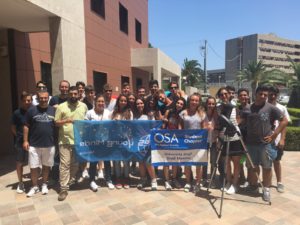 The YM group of Messina have realized many outreach activities. Some of them were carried out in several High Schools of Messina and dealt with the historical development of the main physical branches. First of all we talked about the main personalities that provided fundamental contributions to classical Physics: Galileo and Newton as concerns mechanics and optics, Boltzmann and Clausius for their work on thermodynamics, Maxwell and Faraday that founded the electromagnetic theory. Afterwards we talked about the main consequences of their researches and we showed to the students some theoretical and experimental results. The participants enjoyed two activities the most. In the first place we talked about telescopes and how they work, since we used the one that our group already have. Thus, we organised a sunspots watching, emphasising the significant work done by Galileo Galilei, who first observed these anomalies on the sun surface in 1610. Furthermore, optics experiments got a lot of attention, especially the dispersion of white light by means of a prism. Our aim was to get the students interested in Physics, since it is considered the toughest of all sciences and, for this reason, each year just a few people decide to enrol in our department. We believe that the participants had a good feeling about these experiences, so we hope that either the entries of our department increase and that we will have the opportunity to do again these events.
The YM group of Messina have realized many outreach activities. Some of them were carried out in several High Schools of Messina and dealt with the historical development of the main physical branches. First of all we talked about the main personalities that provided fundamental contributions to classical Physics: Galileo and Newton as concerns mechanics and optics, Boltzmann and Clausius for their work on thermodynamics, Maxwell and Faraday that founded the electromagnetic theory. Afterwards we talked about the main consequences of their researches and we showed to the students some theoretical and experimental results. The participants enjoyed two activities the most. In the first place we talked about telescopes and how they work, since we used the one that our group already have. Thus, we organised a sunspots watching, emphasising the significant work done by Galileo Galilei, who first observed these anomalies on the sun surface in 1610. Furthermore, optics experiments got a lot of attention, especially the dispersion of white light by means of a prism. Our aim was to get the students interested in Physics, since it is considered the toughest of all sciences and, for this reason, each year just a few people decide to enrol in our department. We believe that the participants had a good feeling about these experiences, so we hope that either the entries of our department increase and that we will have the opportunity to do again these events.
On June 11th, some of our members and students of our department took a hike on Mount Etna with a volcanology and alpine guide, Dr. Giuseppe Amendolia. He explained in detail the history of Etna and the events (eruptions, earthquakes) that brought to its actual shape: aside the 5 summit craters, it consists of hundreds of secondary volcanic cones. We organized this jaunt to understand scientifically the phenomena that often affects Sicily, especially Messina and Catania.
The hike started at the University of Messina where all participants gathered in the morning. They moved to Mount Etna, up to the so-called “Rifugio Sapienza” (1910m) where they met Dr. Giuseppe Amendolia at 9 a.m. and started the guided tour. From Rifugio Sapienza they reached 2500m using the cableway and then started the walk. The group visited several minor craters at this altitude and one of the biggest at 2900m. They wanted to walk nearer the summit craters, but rain and fog hindered the excursion. However, the stroll has been tough since it was about 10 km. The participants were satisfied and enthusiast by this activity and hope to come back to end the excursion on the summit craters. This experience gave them the opportunity to better their scientific culture on a theme that is so fascinating. In fact Mount Etna was added to the list of UNESCO World Heritage Sites and is one of the most studied volcanos of Europe and Asia. For this activity we used 600€ allowing 15 participants to take part at this excursion.
Pizza Physics & Beer
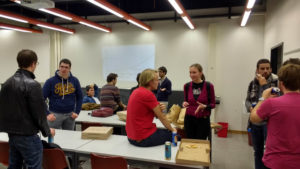 The EPFL Young Minds section expanded with success during its first full year. As planned, monthly seminars were organised under the label ‘Pizza Physics Beer’ (PPB). We noted a rise in participations from 20-30 students per seminar during the first semester, to 30-45 during the second semester. We are now 7 students fully invested in the organisation of the PPB meetings and other events.
The EPFL Young Minds section expanded with success during its first full year. As planned, monthly seminars were organised under the label ‘Pizza Physics Beer’ (PPB). We noted a rise in participations from 20-30 students per seminar during the first semester, to 30-45 during the second semester. We are now 7 students fully invested in the organisation of the PPB meetings and other events.
The subjects covered in the PPB meetings were: nuclear fusion, with a visit to the Tokamak reactor at EPFL; surface treatments to create ultra hard materials; safety measures regarding fission nuclear reactors, and the risks associated with human failure; the fabrication of anti-hydrogen at CERN; correlated dynamics in quantum systems; the use of perovskites for optoelectronic applications; the social behavior of solitons in microresonators.
This seminars were attended by PhD students from the whole EPFL Physics PhD Doctoral School (EDPY) as well as curious master students. This allowed some interaction between students, both during and after the seminar. The after-seminar gatherings lasted, in some cases, more than one hour.
Rogério Jorge, the association’s secretary, attended the leadership meeting of the EPS Young Minds associations in Naples, bringing a large number of innovative ideas to develop within the coming years, including “Physicist Speed Dating” and “Recruiting Event” activities. This first year, made possible by the EPS grants, is clearly encouraging. It reinforced us in our goal to make the EPFL physics community more interactive both within EPFL and with other members of the EPS community.
We are now focusing on the organisation of the physics day: a major event that will take place the October 16 at the Rolex Learning Center, EPFL. The four speakers of this event include the Nobel prize Stefan Hell as well as three other prominent physicists (L. O. Silva, P. Hazzi, A. Kellerer). This event will also be the occasion of a poster competition between the physics PhD students and will foster interactions among physicists of the physics doctoral school of EPFL.
School for Young Physicists
 Another school year has passed, and another SYP season has concluded as well. This year, turnout was at its highest level, with an average of 176 students taking part in each session.
Another school year has passed, and another SYP season has concluded as well. This year, turnout was at its highest level, with an average of 176 students taking part in each session.
The topics covered in the nine sessions throughout the season were:
• Deconstruction of popular urban myths with physics
• The physics of sound
• Radioelectronics
• Astronomy and cosmology
• Simple mechanisms
• Electromagnetism
• The role of numerical solutions in physics
• Geophysics
• General and special theory of relativity
Highlights of the season include (but are not limited to) using an elastic membrane to simulate the bending of spacetime, students being introduced to the numerical Euler’s method, which is never touched upon in any high-school curricula and a UL professor telling everyone the basic idea of why Earth has a magnetic field, explaining the underlying concepts of magneto-hydrodynamics.
The 2nd School Cup was awarded at the end of the season. This year, Aizkraukle Regional gymnasium’s team “Re, kā!” were the winners. They took away the main prize; second and third place winners also received prizes, as did the students that performed best throughout the season. Students thoroughly enjoyed this year, as the season closed with thunderous applause from participants.
Aside from our main sessions, we also participated in a popular nation-wide physics competition “eXperiments”, providing two out of five challenges for contestants to solve in the finals, as well as entertaining the supporters of the contestants with a small show, demonstrating a few fun experiments. The competition is running for the 22nd year, and is well known among teachers in Latvia.
Our summer season has also kicked off: as in previous years, our School for Young Physicists took part in the extreme sport festival “Playground”, once again upping our workshop in size, scope and popularity. As in previous years, staples such as the potato cannon (two, this time) and the tennis ball catapult were set up again, and popular experiments such as the hold-fire-in-your-hand and mushing around in a non-Newtonian fluid were demonstrated.
The full list of experiments and activities (in addition to those already mentioned), all free of charge, includes:
• vinegar and soda bottle rockets
• demonstrations for the gyroscopic effect with a wheel
• a self-programmed puzzle game for all ages
• a membrane for demonstrating spacetime curvature
• a large-sized wave pendulum
The last three activities were new to our workshop setup, and were very successful. In particular, the spacetime membrane with marbles on it acting as planets was popular with kids!
All in all, this year has been a success, and we will look to further improve our monthly sessions and increase the scope of our activities in the future.

